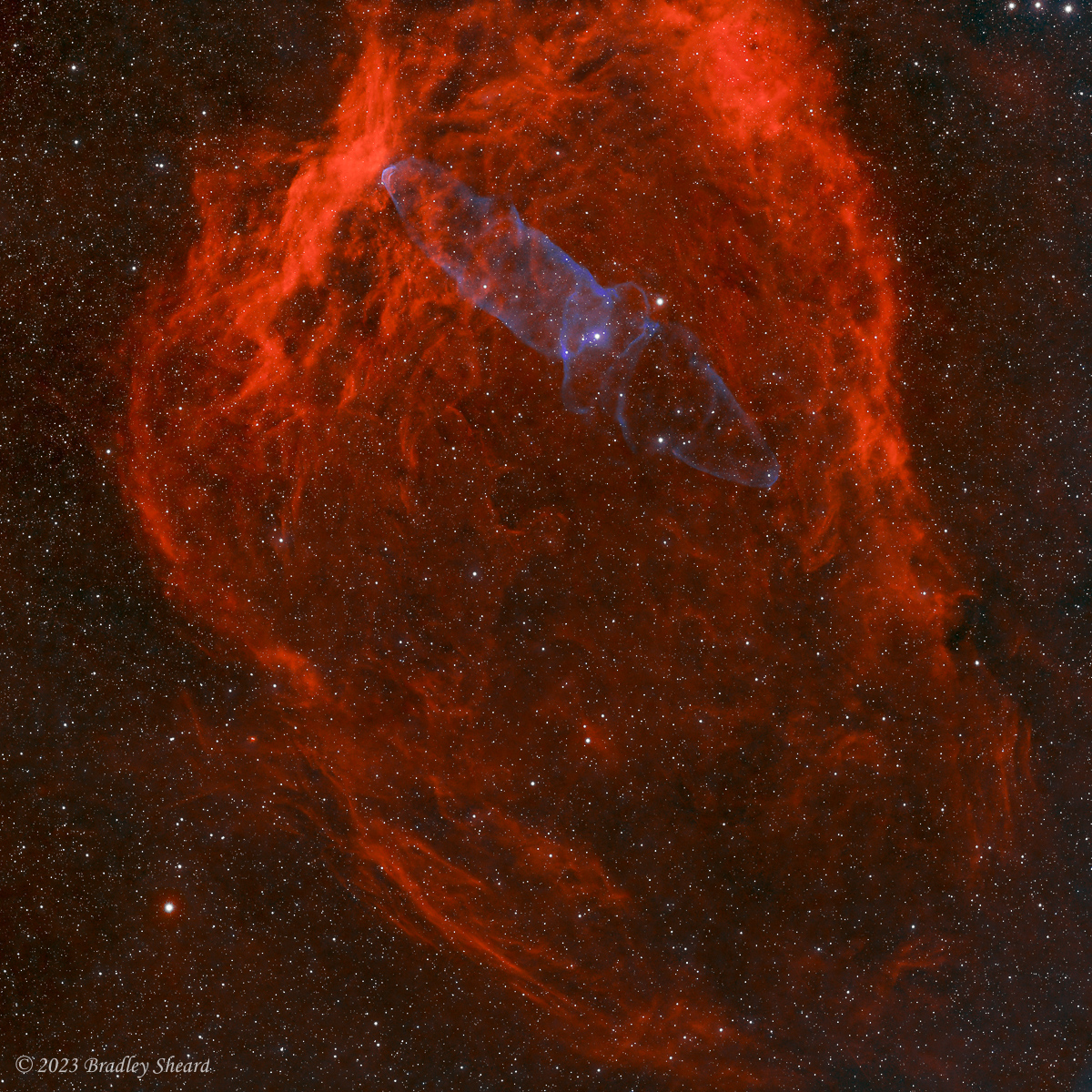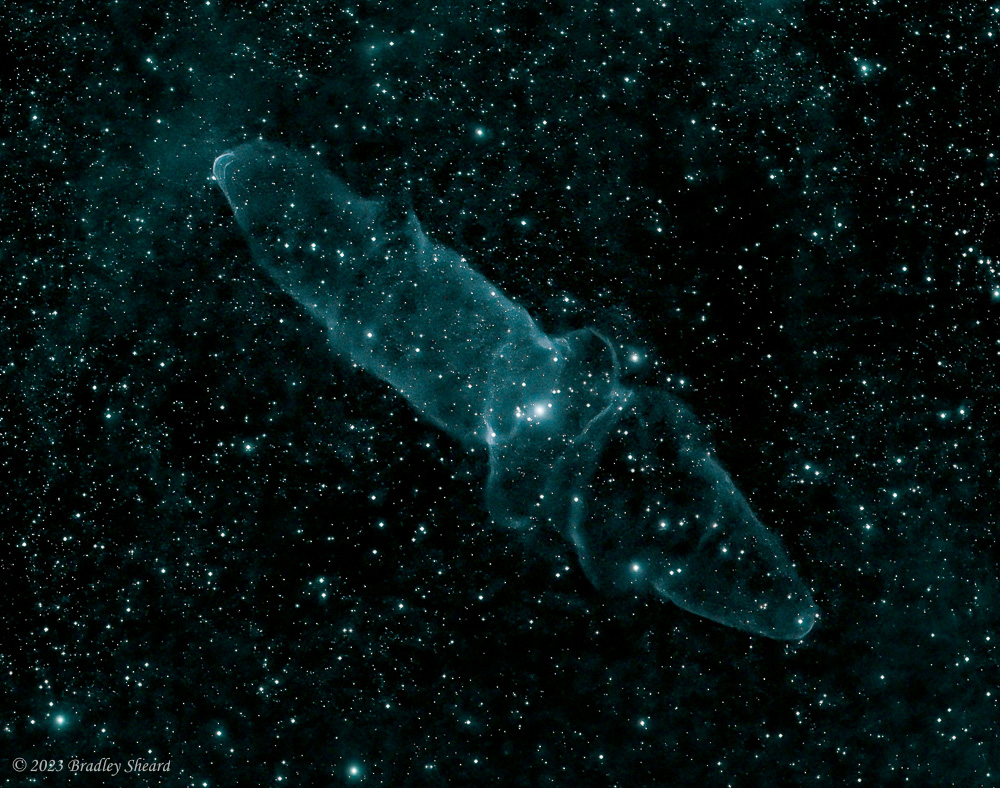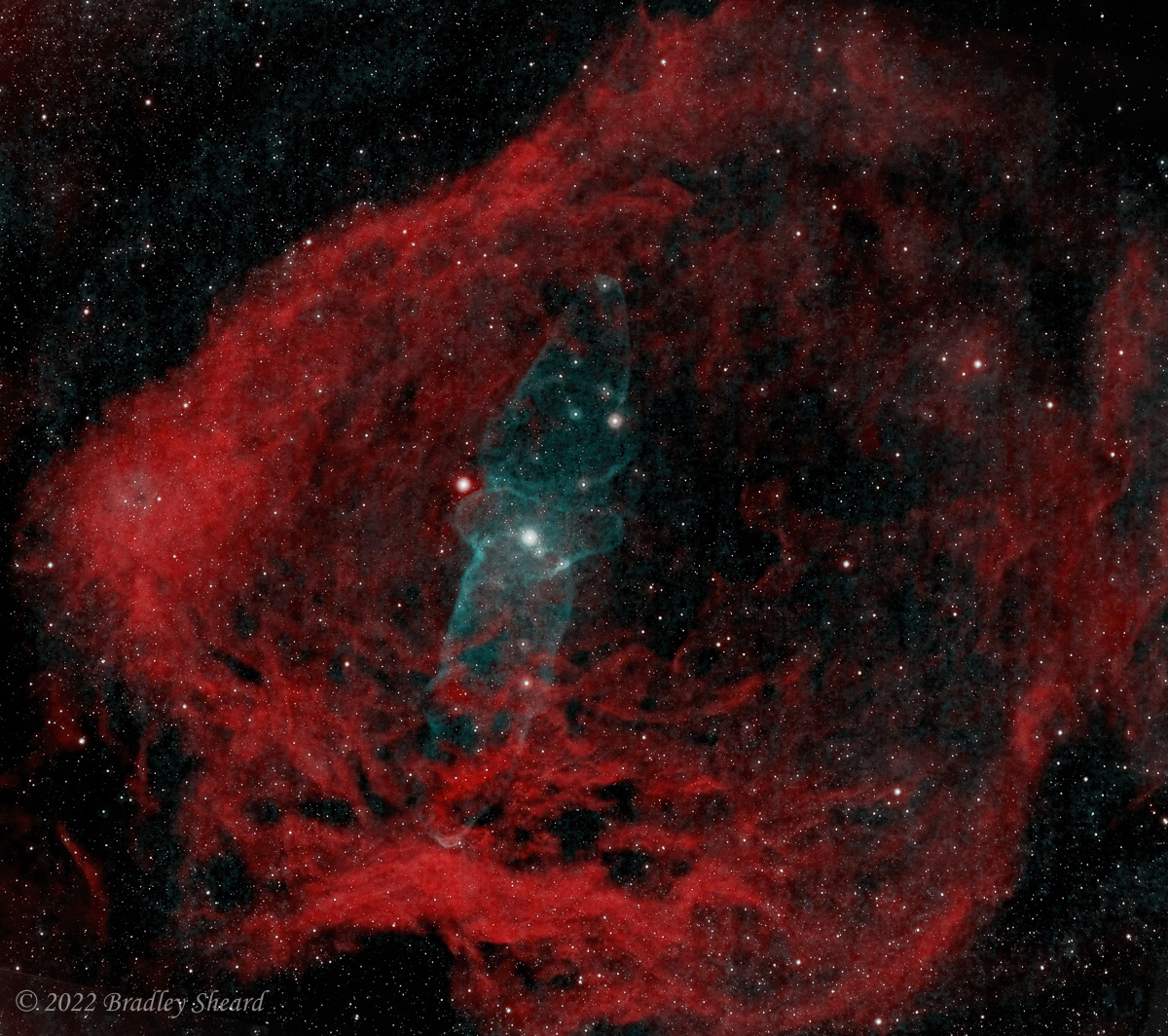Sharpless 2-129 & Outters 4 in the Constellation Cepheus | |||
| « Previous | Back to Astrophotography Gallery | Next » | |
In the constellation Cepheus lies a very faint pair of nebula, the H-alpha dominated Flying Bat Nebula (Sharpless 2-129, the red region here), and the extremely faint Oxygen III dominated Squid Nebula (Outters 4, shown in blue in this image). The Squid Nebula is a bi-polar nebula (possibly a planetary nebula), and was only discovered in 2011 by amateur astronomer Nicolas Outters. | |||
New 2023 Version |
|||
 | |||
| Optics: | Takahashi FSQ-106EDX4 | ||
| Camera: | ZWO ASI 6200MM cooled CMOS camera | ||
| Exposure info: | 3.5 hours H-alpha / 4.0 hours SII / 9.1 hours OIII (binned 2x2) / 16.6 hours total (10 min subs) | ||
| Filters used: | Astrodon H-alpha (5 nm), SII (5 nm) and OIII (3 nm) | ||
| date: | Fall 2023 | ||
| processing: | Pixinsight-->Photoshop-->Topaz DeNoise AI-->Lightroom | ||
| Color palette: | Red = H-alpha, Green = SII, Blue = OIII, with color adjustments | ||
It is interesting to isolate just the OIII (below, blue channel here) to show the faint Squid Nebula (Ou4) more fully, as it tends to get obscured by the bright H-alpha emissions in the composite image above. This bipolar nebula was discovered by French amateur astronomer Nicolas Outters while imaging Sh 2-129 (red nebula in image above) in 2011. This structure only appears when using a narrowband OIII filter, which isolates the Oxygen III emiision line. From Reference 1: "The morphology appears as a complex addtion of two components: a small central disc-like structure and two elongated opposite lobes..." (The elongated lobes are oriented from the upper-left to lower-right in this image.) Note the very bright central star in the nebula, HR 8119, which is listed as a 5th magnitude variable triple star. This star is estimated to have a mass of ~32 x the sun's (Reference 2) and to have a surface temperature of ~ 31,500 K, and estimated to lie 712 pc (2321 light-years) from earth. The exact nature of this nebula is not clear; one possibility is that it is a nearby planetary nebula, the other that it is a massive collimated outflow from a star (possibly HR 8119). One of the intriguing aspects of this nebula is its large size--it spans slighly more than 1-degree, twice the angular diameter of the full moon! This size seems to lead the authors of Reference 1 to conclude that the nebula is not associated with the star HR 8119, since that star's distance and the angular size of the nebula would mean that the nebula would be of truly massive size (25-50 pc according to Reference 1). Reference 2 concludes it likely that Ou4 is located inside Sh 2-129, and that it is an outflow from the apparent central star HR 8119. Citing other authors work Reference 2 states that HR 8119 is the ionizing source of the HII region Sh 2-129, and that they are located at the same distance from our vantage point. It still remains unclear if this is a planetary nebula or simply an outflow from the triple star system that seems to sit at its center. | |||
 | |||
Earlier 2017/2018 Version |
|||
 | |||
This image was shot entirely through narrowband filters; the H-alpha taken from light-polluted Maryland, while the Oxygen III frames were taken both in Maryland and Cape Hatteras, North Carolina, where the skies are considerably darker. The image is a composite of 22 hours of exposure, combining data taken over the course of two seasons. The faint squid nebula was extremely difficult to capture, and to bring out in the processing. | |||
| Optics: | Stellarvue SV70 w/ reducer & William Optics Star 71 | ||
| Camera: | ZWO ASI 1600MM cooled CMOS camera | ||
| Exposure info: | 10 hours H-alpha / 12 hours OIII / 22 hours total | ||
| Filters used: | Astrodon H-alpha (5 nm), OIII (3 nm) | ||
| date: | Fall 2017 & 2018 | ||
References:
1. Acker, A., Boffin, H.M.J., Outters, N., et al. "Discovery of New Faint Northern Galactic Planetary Nebulae," Revista Mexicana de Astronomia y Astrofisca, 48, 223-233, 2012.
2. Corradi, R.L., Grosso, N., Acker, A., Greimel, R. and Guillout, P. "Gas Physical Conditions and Kinematics of the Giant Outflow Ou4," Astronomy & Astrophysics, 570, A105, 2014.